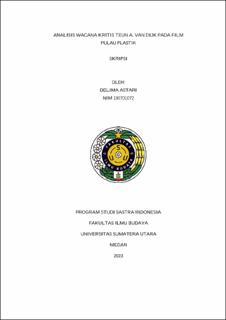| dc.description.abstract | This study aims to analyze Plastic Island film using critical discourse analysis van Dijk model. This research focuses on microstructure and sentence type on Plastic Island film using qualitative descriptive method. Data collection using the method of listen and record with free listening techniques involving cakap. To analyze the data used the method of content analysis and matching method with the technique of sorting determinants. The results of this study found that the documentary entitled Plastic Island describes three elements of critical discourse analysis model Teun A. Van Dijk. In the analysis of the structure of the text there are three aspects to it. On the macro structure, the film themed the dangers of single-use plastic waste. On the superstructure, headings and leads display interrelated situations and comments. In the microstructure, the film contains several elements, namely the background, details, intentions, assumptions, tenses, pronouns, prepositions, conjunctions, lexicon, language style. Furthermore, social cognition discusses the personal circumstances of the characters regarding the garbage emergency that occurs, people's assessment of events, as well as how the characters understand the events around them. Then, the social context shows that government power practices tend to only provide support without providing good solutions for garbage emergency events. Three types of sentences are also found in Plastic Island films. The sentences are in the form of news sentences found as many as 23 data, interrogative sentences that use the word what, how, not, where, how much, and two groups of command sentences, namely the passage sentence with the word please and the Prohibition sentence with the word don't. | en_US |

